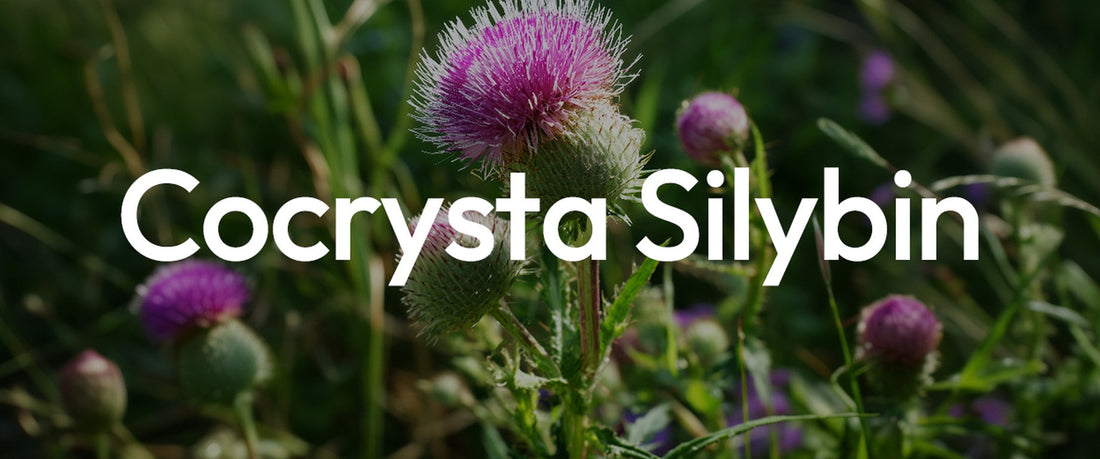
The liver is your body’s hub for metabolism and clearance—handling energy conversion, nutrient storage, and processing potentially harmful substances. In a fast-paced lifestyle, it often works in overdrive. Excessive alcohol, chronic late nights, high-sugar/high-fat diets, and frequent medication use all raise metabolic burden on the liver, quietly accumulating stress over time.
In simple terms: Your liver runs nonstop; everyday habits can chip away at resilience.
Silybin: The Key Active Component in Milk Thistle
Milk thistle (Silybum marianum) is a traditional Mediterranean herb long used for liver support. Its most studied bioactive group is **silymarin**, a mixture of flavonolignans. Among them, **silybin** is the most abundant and bioactive, widely regarded as the “key factor” behind milk thistle’s liver-supportive actions.
In simple terms: Silybin is the principal molecule through which milk thistle exerts many of its studied liver-related effects.
Mechanisms Explored in Research
1. Defending Against Oxidative Pressure
The liver constantly produces reactive oxygen species (ROS) during metabolism. When ROS accumulate, they can damage cell membranes and mitochondria.
Silybin is studied for:
- Direct ROS scavenging
Upregulating antioxidant enzymes (e.g., SOD, glutathione peroxidase) - These actions are theorized to form a dual-layer defense, protecting cell membranes and improving resilience.
In simple terms: Silybin acts as both shield and amplifier—neutralizing radicals and boosting your own antioxidant systems.
2. Modulating Pro-Inflammatory Signaling
Chronic liver stress often involves sustained activation of inflammatory pathways. In many models, silybin:
- Inhibits NF-κB signaling
- Reduces expression of inflammatory mediators (e.g., TNF-α, IL-6)
These actions help reduce hepatocyte inflammation and limit downstream damage.
In simple terms:** Silybin helps "lower the volume" of inflammatory signals to ease liver stress.
3. Supporting Cellular Repair Pathways
Silybin may promote liver cell repair by:
- Enhancing ribosomal RNA synthesis via RNA polymerase
- Boosting protein production for hepatocyte structure and function
- Supporting DNA/RNA synthesis and hepatocyte proliferation
These effects may strengthen the liver’s regenerative capacity over time.
In simple terms:** Silybin contributes to the rebuilding machinery inside liver cells.
Clinical Evidence in NAFLD Contexts (With Caution)
- In a controlled trial with individuals with non-alcoholic fatty liver disease (NAFLD), participants received 2,800 mg/day of silymarin for 90 days.
- Those receiving silymarin showed greater reductions in liver enzymes (ALT, AST) compared to controls.
- No major adverse events were reported.
These findings are context-specific and do not imply a disease-treatment claim.
The Challenge: Poor Absorption of Conventional Silybin
- Silybin is poorly soluble in water, making it difficult to absorb in the digestive tract.
- This results in low bioavailability despite strong therapeutic potential.
In simple terms: Traditional silybin doesn’t dissolve well—so your body can’t use much of it.
Co-Crystal Silybin: Addressing the Absorption Barrier
Co-crystal silybin applies supramolecular crystallization to:
- Alter silybin’s solid-state lattice
- Improve aqueous solubility and stability
- Enhance gastrointestinal absorption
All without changing its pharmacological identity.
In simple terms:** Re-engineering silybin’s crystal form makes it dissolve and absorb far better.
Key Study Findings:
1. In rats, co-crystal silybin achieved:
- 16.2×** higher AUC (total exposure)
- 16.4×** higher Cmax (peak concentration)
2. In a pH 4.5 simulation, solubility was **100×** greater than conventional silybin.
3. In simple terms:** Animal and simulated data show vastly improved bioavailability.
Safety & Use Notes
1. Generally well tolerated** at dietary/supplemental levels.
2. Consult your doctor** if you are:
- Pregnant or nursing
- Taking medications (especially anticoagulants or antiplatelets)
- Managing chronic conditions
3. Always follow product instructions.
In simple terms: Usually well tolerated, but check with a healthcare professional if unsure.
FAQ
Q1: What is co-crystal silybin?
A: It’s the same silybin molecule, engineered into a different crystal lattice to improve solubility and absorption.
Q2: How is it different from silymarin or plain silybin?
A: Silymarin is a mix of compounds; silybin is the main active. Co-crystal silybin focuses on silybin alone, optimized for delivery.
Q3: When will I notice effects?
A: Typically, 8–12 weeks is used for evaluation. Individual responses may vary.
Q4: Should I take it with food?
A: Yes. Even with improved solubility, with-meal use and adequate water are practical.
Q5: Is it safe long term?
A: Generally yes. If you take medications or are under medical supervision, consult your provider.
Reference
1. Surai, P. F. (2015). Silymarin as a natural antioxidant: An overview of the current evidence and perspectives. Antioxidants (Basel), 4(1), 204–247.
2. Polyak, S. J., et al. (2007). Inhibition of T-cell inflammatory cytokines, hepatocyte NF-κB signaling, and HCV infection by standardized silymarin. Gastroenterology, 132(5), 1925–1936.
3. Sonnenbichler, J., & Zetl, I. (1984). Effect of silibinin on RNA synthesis in rat liver in vivo. Hoppe-Seyler’s Zeitschrift für Physiologische Chemie, 365(5), 555–566.
4. Zhang, X., et al. (2017). Silybin cocrystals with improved solubility and bioavailability. Molecules, 22(4), 640. https://doi.org/10.3390/molecules22040640
These statements have not been evaluated by the Food and Drug Administration. This product is not intended to diagnose, treat, cure, or prevent any disease. Individual results may vary. The information provided is for general educational purposes only and not a substitute for professional medical advice.